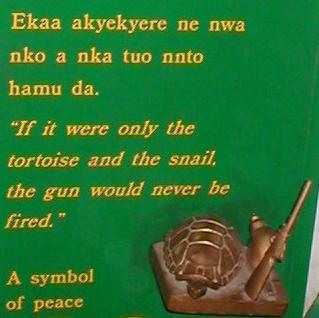Turtles
Saw two turtles trying to cross the road this morning, one at the beginning of my commute and one at the end. Very odd. Later, when flipping through the dictionary to get to "topology" landed on the page with a picture of a tortoise and its definition. Hmmm.
Decided Google might provide some clues. Found a page from someone who'd developed an app called Tortoise CVS. Checked out the "Goals" page, which I liked, and found this unrelated but to me interesting graphic:

Sign spotted at Kakum National Park, Ghana
I went further. I looked up "tortoise symbol" and found that, "In the Himalayan Buddhist astrological context, the tortoise is considered an aspect of Manjushri.
The tortoise has much to do with writing, investigation, scholarship, teaching. Interesting. I tend to think of "slow but steady and determined." Could be "wonderfully auspicious." As long as it doesn't portend a fate such as that of Aeschylus (525-456 BCE), the famous playwright of ancient Greece, who "is said to have been killed by a tortoise which hit him on the head having fallen from the talons of an eagle flying overhead." Perhaps he wasn't getting it, re: turtle wisdom.
Anyway, I hope the turtles made it to the other side.
Saw two turtles trying to cross the road this morning, one at the beginning of my commute and one at the end. Very odd. Later, when flipping through the dictionary to get to "topology" landed on the page with a picture of a tortoise and its definition. Hmmm.
Decided Google might provide some clues. Found a page from someone who'd developed an app called Tortoise CVS. Checked out the "Goals" page, which I liked, and found this unrelated but to me interesting graphic:

Sign spotted at Kakum National Park, Ghana
I went further. I looked up "tortoise symbol" and found that, "In the Himalayan Buddhist astrological context, the tortoise is considered an aspect of Manjushri.
Manjushri is a bodhisattva associated with Vairochana (Tibetan: nangpar nangdze,) the Buddha Resplendent, who is like the sun in glory at its zenith [highest position.] He is the patron bodhisattva of the Kadampa (ie. Gelugpa) denomination, famous for its students of the written word -- scholars or geshes.
His Name
The Sanskrit name Manju-shri is variously interpreted to mean "wonderfully auspicious," or "sweetly glorious." However, in Tibetan his name Jampel-yang (contracted to Jamyang) means "gentle friend." In Chinese, he is called Wen Shu Shi Li; in Japanese, Monju.
Western Buddhist Review, Part 3 of A. Tribe's "Cult of Manjusri"
Another epithet is Vakishvara (Lord of Speech) and it is this aspect of Manjusri that associates him with a great historical teacher known as Manjughosha (the sweet-voiced.)
Role
Manjushri is viewed both as a historical bodhisattva, and as an emanation of Vairochana, ("Berotsana," Tibetan: nangpar nangdze, Jap.: Dainichi Nyorai) the primordial white Buddha that is compared to the sun -- his nature is "everywhere-pervading." He manifests as a bodhisattva to provoke investigation into such topics as Emptiness (or, void-ness,) free will, and the nature of the self.
Paul Harrison's Manjushri and the Cult of the Celestial Bodhisattvas
Attributes
When the primordial buddha Vairochana vowed to emanate throughout the universe as the princely and ever-youthful, bodhisattva of Wisdom, his purpose was to lead beings in an inquiry whereby they could discover the true nature of reality. For that reason, he is usually depicted displaying the two tools essential to that investigation: in his right hand he wields the double-edged sword of logic or analytic discrimination and in his left, the Prajnaparamita Sutra, the text of the teaching on Emptiness. This teaching is fundamental to all forms of Buddhism and for that reason it is often called "Mother of All Buddhas." It is cushioned on the lotus of Compassion.
Manjushri's sword of discriminating wisdom is tipped with flames to show that it severs all notions of duality. It can cut away delusion, aversion and longing, to reveal understanding, equanimity and compassion.
The tortoise has much to do with writing, investigation, scholarship, teaching. Interesting. I tend to think of "slow but steady and determined." Could be "wonderfully auspicious." As long as it doesn't portend a fate such as that of Aeschylus (525-456 BCE), the famous playwright of ancient Greece, who "is said to have been killed by a tortoise which hit him on the head having fallen from the talons of an eagle flying overhead." Perhaps he wasn't getting it, re: turtle wisdom.
Anyway, I hope the turtles made it to the other side.

